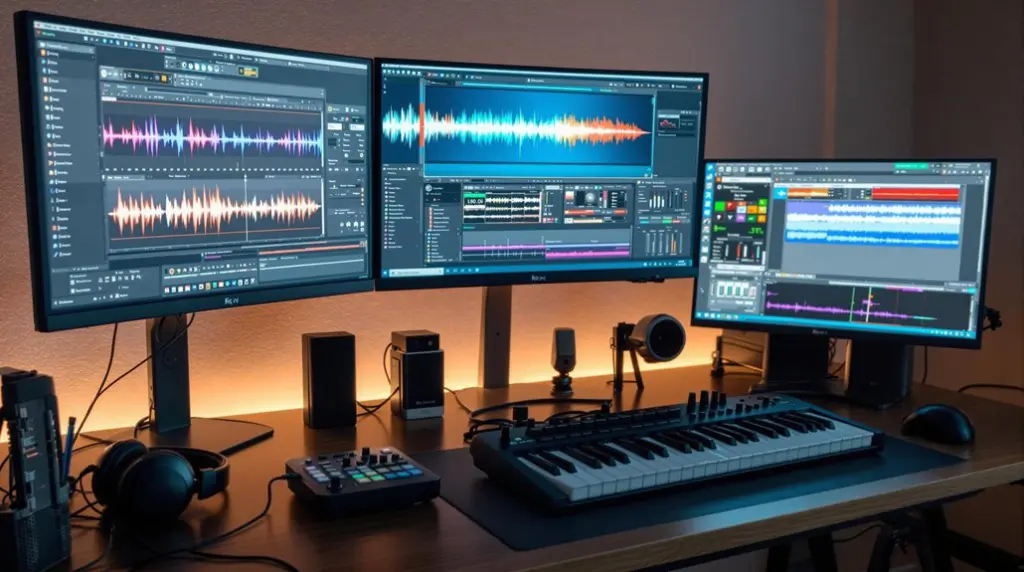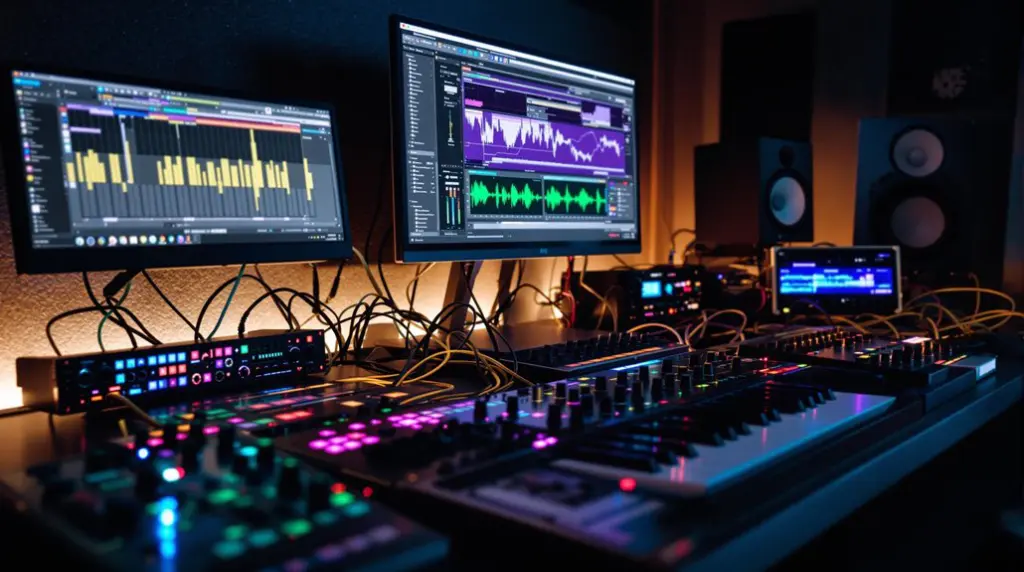The Roland SH-101, introduced in 1982, became a bedrock for electronic music, thanks to its affordability and portability. This monophonic synthesizer features a CEM-3340 oscillator and IR3109 filter chip, delivering vibrant sounds with dynamic pulse width modulation and resonant filter sweeps. Its intuitive design, with a lightweight form factor and straightforward interface, makes hands-on experimentation a breeze. Enhancements like a built-in sequencer and arpeggiator further encourage creative exploration. Today, its collectibility is bolstered by endorsements from icons like Aphex Twin. Its distinguishable sound and impact on genres from techno to acid house continue to resonate strongly with musicians and collectors, enticing a deeper appreciation.
Key Takeaways
- The Roland SH-101’s affordability and portability democratized music production in the 1980s and 1990s.
- Its unique sound characteristics, including the CEM-3340 oscillator and IR3109 filter chip, distinguish its bright, edgy tones.
- The intuitive design and monophonic structure encourage hands-on experimentation and creativity.
- The built-in sequencer and arpeggiator enhance creative sequencing capabilities, despite their simplicity.
- The SH-101’s historical impact and endorsements from artists like Herbie Hancock and Aphex Twin solidify its iconic status.
History and Legacy
The Roland SH-101, introduced in 1982, swiftly became a cornerstone in the domain of new wave and electronic music, thanks to its straightforward design and distinctive sound characteristics. Its historical significance is particularly evident in the early 1990s when it became integral to the burgeoning house and techno music scenes.
This period marked a pivotal moment in synth evolution, where the SH-101’s bright, edgy tones influenced numerous tracks and genres, solidifying its cultural impact. The SH-101’s affordability and portability democratized music production, making it accessible to a new generation of musicians. This accessibility contributed to its resurgence in popularity decades after its initial release, reflecting its lasting relevance in the music industry.
Additionally, its influence extended to genres like Drum and Bass, where its unique sound added a new dimension to the genre’s intricate drum patterns and deep basslines. Endorsements by notable artists such as Herbie Hancock and Aphex Twin further cemented its status as a seminal instrument.
As part of a lineage that includes iconic models like the 808, 909, and 303, the SH-101 holds a distinctive place in the history of synthesizers. It has not only shaped sound design techniques but also left an indelible mark on music culture, illustrating the profound cultural impact of this quintessential synthesizer.
Unique Sound Characteristics
Renowned for its singular sonic footprint, Roland SH-101 stands out due to its CEM-3340 oscillator, which delivers three distinct wave shapes: triangle, sawtooth, and variable pulse. These oscillator waveforms provide a broad timbral palette, allowing musicians to craft a variety of sounds, from smooth, rounded basses to sharp, cutting leads.
Central to the SH-101’s unique sound is its IR3109 filter chip. This filter not only supports resonant filter sweeps but can also self-oscillate at high resonance settings, adding a rich and dynamic quality to the sound. The ability to fine-tune the filter resonance is essential, enabling users to achieve everything from subtle tonal shifts to pronounced, whistling peaks.
Pulse width modulation (PWM) further enhances the SH-101’s sonic versatility. By modulating the pulse width of the variable pulse waveform, users can introduce a dynamic, evolving character to their sounds, resulting in richer textures and more engaging soundscapes.
For additional clarity and balance, musicians can utilize high-pass filters to eliminate unnecessary low frequencies. The integration of an ADSR envelope controlling both the VCF and VCA offers additional flexibility in shaping the sound’s dynamics and articulation.
Coupled with a built-in sequencer and arpeggiator, the SH-101 becomes a powerful tool for creative sequencing and unique rhythmic explorations, cementing its status as a synth icon.
Intuitive Design
A hallmark of the Roland SH-101 is its intuitive design, which seamlessly bridges accessibility and functionality. The synthesizer’s straightforward interface allows users to easily navigate its sound parameters, making it equally accessible for beginners and experienced musicians. This user-friendly layout is highlighted by dedicated knobs for essential functions such as filter cutoff, resonance, and envelope settings, enabling quick and precise adjustments during live performances.
The SH-101’s compact and lightweight design further enhances its user experience by offering superior portability without compromising on functionality. Musicians can easily transport this synthesizer, making it an ideal choice for both studio and live settings.
The monophonic structure and simple architecture of the SH-101 encourage hands-on experimentation, fostering creativity and exploration in sound design. This aspect is particularly beneficial for those new to synthesis, as it reduces the learning curve and promotes immediate engagement.
Moreover, the synthesizer’s built-in sequencer and arpeggiator are designed with user accessibility in mind, allowing for immediate capture of musical ideas without the need for complex programming.
Essentially, the Roland SH-101’s intuitive design makes it a timeless tool for musicians seeking simplicity and versatility in their sonic endeavors.
Sequencer and Arpeggiator
Integral to the Roland SH-101‘s appeal, its sequencer and arpeggiator offer musicians powerful yet straightforward tools for crafting intricate musical ideas. The built-in sequencer, despite lacking visual indicators, excels in promoting sequencer creativity. Users can effortlessly craft complex polyrhythms, owing to its intuitive design and straightforward layout.
The inclusion of legato and rest functions further enhances its capabilities, allowing for more expressive and dynamic musical phrases. These features are reminiscent of modern digital signal processing techniques used in advanced DAWs.
While the SH-101’s arpeggiator provides basic arpeggiation, it does have notable limitations. The absence of a random mode reduces variability in note triggering, potentially limiting the scope of experimental compositions. However, this simplicity often leads to serendipitous rhythmic patterns, making it a valuable tool for spontaneous music creation.
Enhancing the SH-101’s sequencer, the Tubbutec SH-1oh1 mod introduces additional functionalities that greatly expand its creative potential. For instance, users can now explore more intricate sequencing possibilities, transforming the SH-101 into an even more formidable instrument for innovative music production.
Consequently, while the SH-101’s sequencer and arpeggiator may have certain limitations, their overall contribution to the synth’s iconic status remains undeniable.
Comparisons With Other Synths
When comparing the Roland SH-101 with its modern counterparts, several distinctions arise.
The SH-01A, for instance, extends the original’s capabilities through polyphony and MIDI integration, while the Elektron Analog Keys combines a faithful sound emulation with an advanced sequencer.
Meanwhile, despite the Behringer MS-1‘s attempt to clone the SH-101, purists still favor the original’s unique filter resonance, setting it apart from other contemporary alternatives such as the Novation Bass Station II and Radikal Technologies Spectralis 2.
SH-01A Vs SH-101
In the domain of synthesizers, the comparison between the SH-01A and the SH-101 reveals a fascinating evolution from classic to contemporary. The SH-01A features a robust metal build, which contrasts with the SH-101’s plastic construction, providing increased durability especially valued by touring musicians.
This modern iteration also boasts MIDI compatibility and the ability to produce up to four voices, offering considerably more versatility compared to the monophonic SH-101.
Despite its advancements, the SH-01A retains the SH-101 nostalgia through its design and core sound architecture. The original SH-101 is celebrated for its unique filter characteristics and simplicity, which have become iconic in the world of synthesizers.
However, the SH-01A enhances this legacy by incorporating contemporary features such as a USB port for seamless connectivity and modern effects, improving its suitability for today’s diverse musical setups.
Moreover, the SH-01A’s enhanced programmability and storage options cater to modern musicians’ needs, providing a broader sound palette while maintaining the essential elements that made the SH-101 legendary.
This synthesis of old and new makes the SH-01A a compelling choice for both purists and innovators.
Analog Keys Capabilities
The world of analog synthesizers continually evolves, and the Elektron Analog Keys stands out as a demonstration to this progression.
While the Roland SH-101 is revered for its monophonic charm, the Analog Keys introduces polyphonic capabilities, allowing for up to four voices. This polyphony considerably enhances the complexity and richness of arrangements, a crucial feature for modern musicians seeking versatility.
Moreover, the Analog Keys boasts an advanced sequencer, surpassing the simplicity of the SH-101’s step sequencer. This advanced functionality provides musicians with more creative control and flexibility in crafting intricate sequences.
In addition, the built-in effects section of the Analog Keys, which includes reverb, delay, and overdrive, permits extensive sound shaping directly within the instrument—a aspect absent in the original SH-101.
Connectivity is another area where the Analog Keys excels, offering thorough MIDI integration. This guarantees seamless interoperability with other contemporary devices, a notable upgrade from the SH-101’s limited CV/Gate connectivity.
Finally, the Analog Keys’ metal build enhances its durability, making it more suitable for the rigors of live performance compared to the plastic construction of the SH-101.
Consequently, while the SH-101 remains iconic, the Analog Keys represents a sophisticated evolution in analog synthesis.
Modern Alternatives Overview
As we explore the landscape of modern analog synthesizers, it becomes apparent that several contemporary models seek to enhance and expand upon the foundational elements of the Roland SH-101. The Roland SH-01a, for instance, introduces MIDI capabilities and a robust metal build, while extending its functionality to up to four voices, a significant leap from the SH-101’s single-voice design. This evolution caters to both vintage enthusiasts and modern producers, blending classic sound design with contemporary flexibility.
The Elektron Analog Keys stands out by offering a convincing SH-101 sound profile, coupled with an advanced sequencer. This combination provides musicians with versatility and depth, making it an indispensable tool for intricate synth evolution and thorough sound design.
Meanwhile, the Radikal Technologies Spectralis 2, with its four oscillators and analog filters, diverges from the SH-101’s straightforward approach, offering a broader sound palette for adventurous sound sculptors.
Behringer’s MS-1 aims for authenticity, replicating the SH-101’s sound profile. However, its filter resonance is criticized for lacking the inharmonic peak, resulting in a somewhat hollow sound.
Market Value and Collectibility
Market value and collectibility of the Roland SH-101 have surged dramatically since its release in 1982, evolving from an affordable synthesizer to a prized asset in the world of vintage electronic instruments.
Initially priced around $500, the SH-101 now commands market values that can exceed $2000, driven by market trends and vintage demand. This dramatic increase is rooted in several factors:
- Historical Significance: Collectors highly value the SH-101 for its unique sound and its pivotal role in the evolution of electronic music. Additionally, its distinctive monophonic capability and historical value have cemented its status.
- Market Dynamics: The fluctuating market for vintage gear, combined with the rarity of well-maintained units, has amplified its desirability and price.
- Endorsements: High-profile musicians like Herbie Hancock have endorsed the SH-101, further cementing its status as a must-have for collectors.
- Community Appeal: The SH-101 continues to captivate a dedicated community of enthusiasts, enhancing its collectibility.
These elements collectively underscore the SH-101’s transformation from a mainstream instrument to a coveted piece of musical history.
This trend reflects broader market dynamics where vintage synthesizers are increasingly viewed as valuable collectibles, making the SH-101 an enduring icon.
Influence on Music Genres
While the Roland SH-101‘s market value and collectibility have seen remarkable growth, its influence on music genres is equally noteworthy. Emerging as a cornerstone in the early 90s house and techno scenes, the SH-101’s bright, edgy tones and versatile bass and lead capabilities became defining elements in the sound of genres like acid house and drum & bass. Its simplicity and portability offered a new generation of musicians an accessible yet powerful tool, making it a staple in both live performances and studio recordings.
The SH-101’s impact on techno evolution cannot be overstated. Artists such as The Prodigy, Orbital, and Aphex Twin have harnessed its unique sonic characteristics, pushing the boundaries of electronic music. The instrument’s straightforward design allowed for intricate sound manipulation, contributing notably to the genre’s development. Understanding song structure and melodic elements, as highlighted in music theory, also played a role in artists maximizing the SH-101’s potential.
Furthermore, the SH-101’s legacy continues to echo in contemporary electronic music. Many modern producers cite it as a pivotal influence in their sound design and production techniques. Its role in shaping new wave and electronic music in the 1980s laid a foundation that continues to inspire and evolve, cementing the SH-101 as an enduring icon in the synthesis world.
Frequently Asked Questions
What Is the History of Sh-101?
The Roland SH-101, introduced in 1982, is renowned for its simple monophonic design and CEM-3340 oscillator chip. Its features and enduring legacy have influenced electronic music genres, making it a sought-after vintage synthesizer.
When Did the Roland SH-101 Come Out?
The Roland SH-101, renowned for its synth features and iconic sounds, was released in 1982. Its monophonic design, affordability, and portability contributed considerably to its enduring popularity among musicians and producers in various music genres.
Is Roland a Synthesizer?
Roland is a prominent manufacturer renowned for its synthesizers, offering exceptional analog synthesis and iconic sounds. Their instruments, such as the SH-101, are celebrated for their historical significance and impact on electronic music production.
What Colors Are Sh-101?
The Roland SH-101 was available in classic black, striking blue, and vibrant red, with a rare white version highly sought after. These design variations and their color significance reflect the bold 1980s aesthetic, enhancing its visual and collectible appeal.
Conclusion
The Roland SH-101’s enduring legacy is attributable to its distinctive sound, user-friendly design, and versatile sequencer and arpeggiator. When compared to other synthesizers, it stands out for its unique characteristics and historical significance. Its market value and collectibility further underscore its status as an iconic instrument. The SH-101’s profound influence on various music genres solidifies its place in the annals of electronic music history, making it an essential subject of study for enthusiasts and scholars alike.




